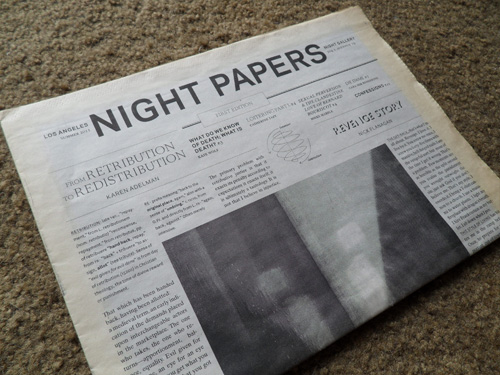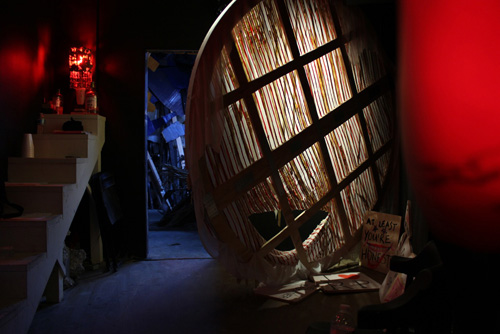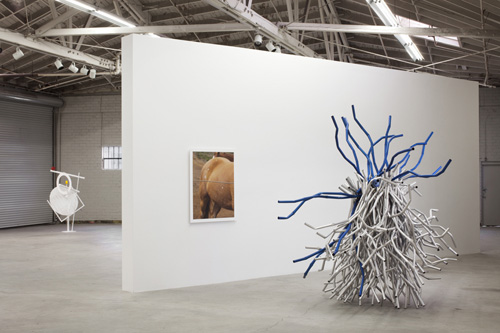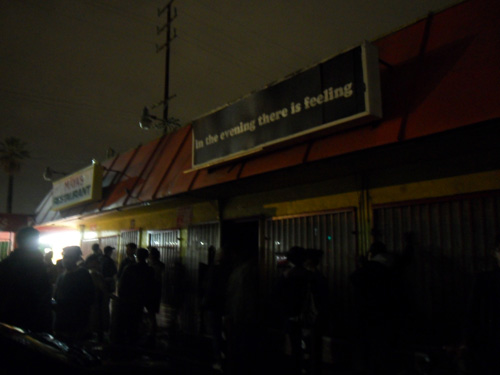
The first issue of Night Papers, published August 2011.
Since January, all eyes in the Los Angeles art world have been on Night Gallery, an edgy little art space that is making the unusual move of expanding and professionalizing its empire. Founders Davida Nemeroff and Mieke Marple, who started the critically acclaimed Night Gallery in a rundown eastside strip mall, have decided to take their concept to the next level, moving into a huge downtown warehouse custom-designed by noted architect Peter Zellner and striving for a significant presence on the international art fair circuit. The midweek, late-night hours and cramped rooms that once distinguished the gallery have been abandoned in favor of brilliant natural sunlight illuminating luxurious corridors of exhibition acreage.
While their programming remains the same and the shows still have an attention-grabbing rigor, a degree of intimacy has been noticeably lost. Night Gallery felt at one time like a secret, a hidden chamber beneath the city, a mysterious shadow who whispered furtive messages in your ear in the hours when you should have been sleeping. Those messages still get whispered from time to time, but they are more elusive now; I heard a few, for example, during a little-publicized but highly fascinating performance by Zeesy Powers, attended by just a few people in February.
The intimacy and punk-rock feel of the old gallery can still be most reliably found in the pages of Night Papers, an occasional publication whose fourth issue comes out this week. Printed in a disposable newsprint format, Night Papers is a literary journal that has the look and feel of a humble neighborhood rag but is full of those surprising moments of lurid candidness, lyrical intellectualism, and odd humor that used to happen late at night in the old space. As Nemeroff says:
“Although Night Papers has been developed alongside Night Gallery, the paper remains a radical exhibition space for a hyperbolic belief system (we make sure things that went unnoticed in our program get articulated in the paper). And while the gallery is constantly at odds between being professional and radical, Night Papers doesn’t face the same sort of pressure or scrutiny…and for that I am very grateful.”

Christine Wang. “Repetition Compulsion,” 2012. Installation view at the old Night Gallery space.
Photo: Davida Nemeroff. Courtesy Night Gallery.
On the occasion of the first Night Papers to be published following the gallery’s move, I interviewed Nemeroff and Kate Wolf, who serves as the paper’s editor. Wolf recounted the paper’s genesis for me:
“We were all sitting around the old Night Gallery one evening and started talking about how fun it would be if there was something like a community bulletin or newsletter for the gallery. At first I think we imagined it as a mix of gossip and actual information about Night Gallery exhibitions and artists, and beyond that about the neighborhood of Lincoln Heights itself as well as other parts of L.A.—basically just a record of everything that was going on in that moment. A few months passed and…we got Lauren Mackler from Public Fiction involved as a designer, but also as another person to help conceive of what the paper would be (and in the meantime Lauren was also working on the first issue of her own publication, so there was a certain synergy among us all).”
Wolf further explained the paper’s ethos:
“In the beginning, I think we wanted the paper to have an ephemeral quality—not precious or collectible, an object that could easily (and we imagined would) end up in the trash or littering the street—as well as an archival element. Something you could come across ten years later and learn from: learn what businesses were around Lincoln Heights, what people were affiliated with the gallery, learn something of what the city was like then. There was definitely a kind of ‘if these walls could talk’ (as in the gallery’s walls) ambition that I think still stands to some degree, but as the paper has grown, we’ve also had to meet it on its own terms more and take on the format in a more ambitious way each time.”

“Made in Space,” curated by Laura Owens and Peter Harkawik, 2013. Installed in the new Night Gallery space. Photo: Lee Thompson. Courtesy Night Gallery.
The first issue of Night Papers was launched in a bundled edition together with the first issue of the Public Fiction journal in August 2011. It included artists’ meditations on revenge and retribution, Wolf’s essay on the death of a friend, a consideration of love and lust by Marple, a mock gossip column by Catherine Taft, and various anonymous confessions. Subsequent issues have featured a wide array of poems, essays, stories, excerpts, images, and evocative texts that can’t quite be categorized.
In the unassuming pages of Night Papers beats the eternal heart of Night Gallery; as Nemeroff says:
“In my experience, the most powerful and magical organisms happen under the radar. That is to say, you can do way more when no one is watching you; that’s when you can really be subversive. I believe Night Papers holds the answer to the long winded question, ‘What is Night Gallery?’ The proof is in the pages, between the ads. It holds the secret. And although Night Papers is a slow burn, it still reminds me of the early days, when the sound of laughter was the loudest sound you heard.”

Opening reception, “Invagination/Write to Life,” final show at the old Night Gallery space, 2012. Photo: Carol Cheh.



